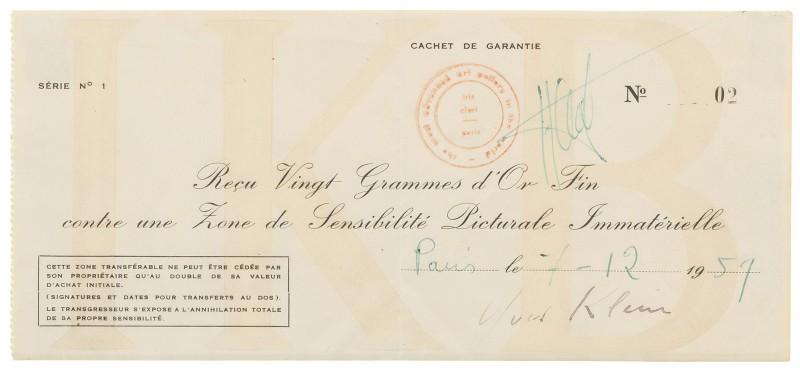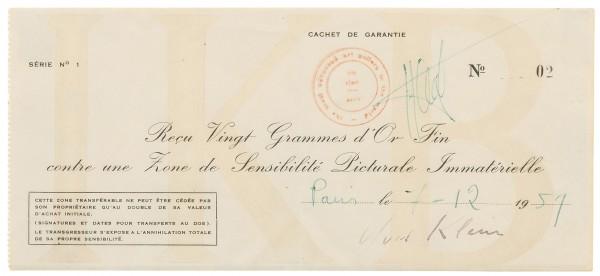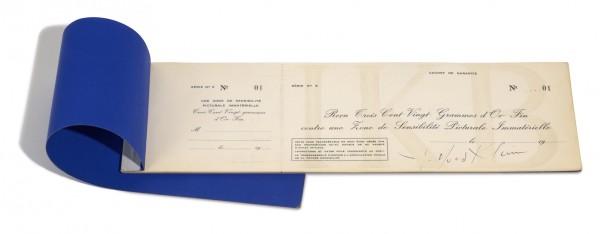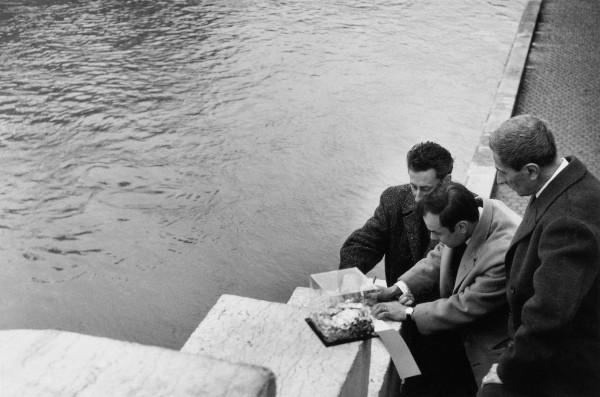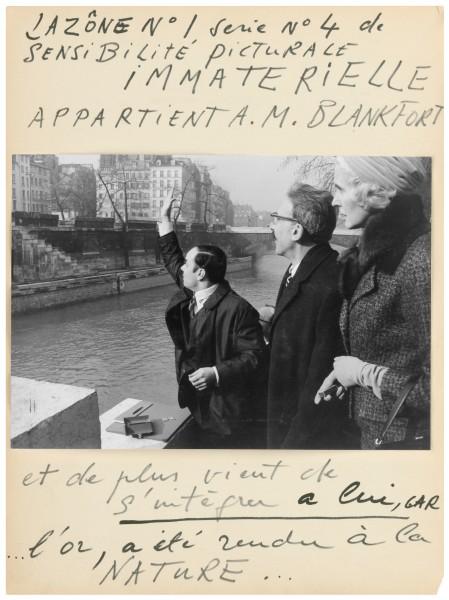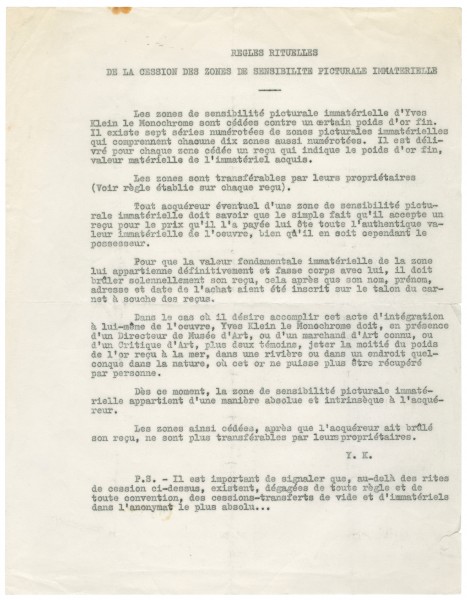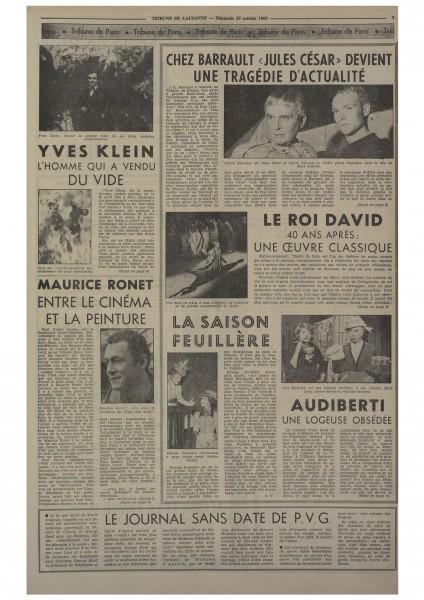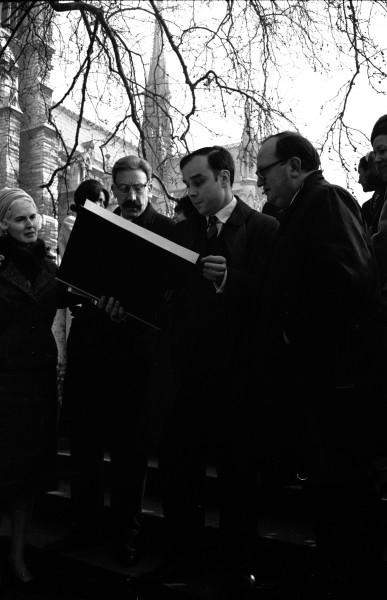Nearly 60 years after his death, the full significance of Yves Klein's masterpiece, the Zones of Immaterial Pictorial Sensibility, is just beginning to be recognized by the art world. Much of this new recognition is coming against the backdrop of the sea change currently consuming the art world: the adoption of blockchain technology and non-fungible tokens (NFTs.)
It may seem strange that an artist whose work was so elemental--composed from fire, wind, and hypnotic solid colours--should find a new audience in the highly technical world of blockchain and cryptocurrency. However, NFTs formalize and automate a process that Klein pioneered in his Receipts for the Zones: the separation of the artwork into both a financialized and non-financialized aspect. Thus, blockchain tokens and NFTs have become a surprisingly effective analog for some of the ideas that made Klein's work so revolutionary. Furthermore, there is a compelling case to be made that the receipt for the Zone of Immaterial Pictorial Sensibility is, in essence, the first NFT.
In the 1960s, the most important technological innovation in art was the certificate of authenticity. Those certificates created by conceptualists like Sol LeWitt, Robert Morris, and Hans Haacke built upon the possibilities for art laid out by Marcel Duchamp almost 50 years earlier. By Duchamp's understanding, art was any object or action that was nominated as such by the singular authority of the artist. For artists in the 1960s, the certificate was a way of formally declaring their artistic intent, and implicitly their own authority. Much of the conceptual work of the 1960s is built on the leveraging of this authority.
Today, the most important technological innovation in art is once again the certificate of authenticity. This time, however, those certificates are being generated on the blockchain as non-fungible tokens (NFTs.) These digital certificates of authenticity build upon the more expansive possibilities for art laid out by Yves Klein more than 50 years ago. Klein's understanding of art was broader in the way he recognized the contexts through art was absorbed (the white walls of the gallery were his obstacle, never his crutch), and deeper in the sense of connection he tried to create with his viewers (he aimed to do nothing less than "literally impregnate" viewers with his sensibility.) Like the conceptualists who followed him, his work was intelligent and rigorous, and also leveraged his own considerable artistic authority. Like the pop artists who followed, Klein recognized that viewers accessed that intelligence and strengthened that authority through very temporal media: publicity and the markets. But Klein's aim was also profoundly metaphysical, drawing viewers into a sincere, spiritual depth which feels far away from the coolness of the Conceptualists or Pop artists. Klein was conceptual before Conceptualism, pop before Pop Art, and he was something else entirely that we haven't seen since.
In order to contain these seemingly contradictory multitudes, Klein's artworks were, in a sense, divided into different dimensions: to experience one of his artworks was to move through a procession of that work's multiple aspects. ("First there is nothing, then there is a deep nothing, then a blue depth," Klein once proclaimed at an exhibition of his work.) The division and specialization of these aspects was the brilliant technique which allowed him to create work of both profound depth and broad appeal. This understanding is most perfectly expressed in his Zones of Immaterial Pictorial Sensibility.
The Zones were the apotheosis of Klein's lifelong quest to create an artwork which was "a direct and immediate perception--assimilation without any effect, any trick, or any deception." In other words, he was aiming to directly transmit the power of painting--its sensibility--without depending on the painting-artifact to act as a medium. The first viewers of these Zones (which was initially called "The Void") in 1958 queued up for blocks outside Galerie Iris Clert in Paris. They walked past the gallery windows blocked out in International Klein Blue, then proceeded through a blue curtain. Finally they entered the gallery to find it had been emptied of all its contents save for--according to Klein--the "pure sensibility of the colour blue." This sensibility had no physical or visible aspect: it was simply the full power of the artist, preserved in a space through his own force of will.
The "specialized and stabilized" sensibility that Klein created was the true content of the work. It was radical and existed in a dimension which we must admit is impossible to locate. However, Klein worked in more conventional dimensions to reinforce this sensibility and to allow viewers to enter into it.
Klein was fond of creating processions for his viewers, guiding them step-by-step into his radical ideas, rather than coldly throwing then straight "into the void." Thus his exhibition of the Zones typically included theatrical elements like the blue windows and curtains at Galerie Iris Clert, that prepared viewers sensorially for the Zones. In addition, Klein was an expert showman who created a media landscape that sparked curiosity about around "the void" and prepared viewers intellectually for the Zones. The classic headline "Klein Vend du Vent!" is a perfect example of Klein using sensationalism to service his sensibility.
But there was one other dimension in which Klein worked fearlessly; one which very few artists since have been able to work as thoughtfully and sincerely: the financial dimension. Klein acknowledged that artworks do exist in the financial aspect, but rather than feign outrage at the vulgarity of the financialization of artwork, he saw it as yet another way through which viewers or collectors engage with the work. Hence, his earliest exhibition of monochromes set unique prices for seemingly identical canvases. Klein was delighted by the fact that collectors chose to pay different prices for the pieces, believing that these unique transactions reflected the buyers' unique relationships to the work. By the time he created the zones, the financial aspect of the work was not just a data point for measuring a collector's perception of an artwork's sensibility, it was an instrument which enhanced that perception, and even liberated the sensibility itself.
Klein considered for a long time how exactly these Zones of Immaterial Pictorial Sensibility should be sold. Eventually, he settled on a system which is the spiritual precursor for the model we are seeing used for the sale of digital art via NFT: he created a separate artifact for the financial aspect of the artwork. This was the humble, but brilliant, receipt.
The receipt performs multiple functions. Firstly, the receipt enables another type of procession. Ownership of the receipt is a step towards understanding the "intrinsic" ownership of the immaterial artwork-proper, which is only conferred upon the relinquishment of the receipt.
Secondly, the Receipt for the Immaterial Zone is the artifact which links us to the artist's sensibility, without forcing that sensibility to take a form which would betray the purity of the artist's intention. The receipt absorbs what Klein called "the problematics of art." Klein finds liberation through the separation of the artwork and its receipt. Because the financialized aspect of the art is safely contained in a simple piece of paper, the spiritual aspect of the art is free to take whatever form Klein desires--even a non-form.
If there is a future for NFT art, and there are many indicators that NFTs are the future of art, Yves Klein's work stands alone as the original exemplar of what exploration is possible through this technology. The Receipt for the Zone of Immaterial Pictorial Sensibility is a brilliant, prescient work which provides a template for the artists of the next generation.
Mitchell F Chan
